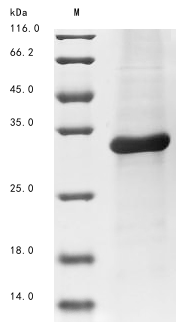Recombinant Mouse Complement C1q-like protein 3 (C1ql3) is produced using a baculovirus expression system and covers the complete mature protein sequence from amino acids 21 to 255. The protein includes an N-terminal 10xHis tag and a C-terminal Myc tag, which provides flexible options for detection and purification. SDS-PAGE analysis confirms the product achieves greater than 85% purity, though this level appears adequate for most research applications.
Complement C1q-like protein 3 belongs to the complement system, a network that may play important roles in immune responses. Scientists have become particularly interested in C1ql3 because it seems to influence synaptic function and plasticity. The protein is likely involved in neural pathway interactions, making it valuable for researchers who study neuronal communication and how synapses organize themselves. However, the full extent of its role in complex neural networks remains an active area of investigation.
Potential Applications
Note: The applications listed below are based on what we know about this protein's biological functions, published research, and experience from experts in the field. However, we haven't fully tested all of these applications ourselves yet. We'd recommend running some preliminary tests first to make sure they work for your specific research goals.
Mouse C1ql3 is a complement C1q-like protein that requires precise folding, proper disulfide bond formation, and specific tertiary structure for its functional activity in synaptic organization and complement system regulation. The baculovirus-insect cell expression system provides a eukaryotic environment that supports proper protein folding, disulfide bond formation, and some post-translational modifications, increasing the probability of correct folding compared to prokaryotic systems. However, C1ql3 is known to form trimers and may require specific oligomerization for full functionality. The dual N-terminal 10xHis tag and C-terminal Myc tag may sterically interfere with the protein's functional domains or oligomerization interfaces. While the expression system is favorable, experimental validation remains essential to confirm structural integrity and functional activity.
1. Antibody Development and Validation Studies
This application is highly suitable as antibody development relies on antigenic sequence recognition rather than functional protein conformation. The full-length mature protein provides comprehensive epitope coverage, enabling the generation of antibodies against both linear and potential conformational epitopes. The high purity (>85%) ensures minimal contamination-related issues during immunization.
2. Protein-Protein Interaction Studies
This application requires proper folding validation. C1ql3 interactions with receptors like Bai3 and other synaptic partners require precise tertiary and quaternary structure. If correctly folded and oligomerized (verified), the protein may be suitable for interaction studies. If misfolded/unverified, there is a high risk of non-specific binding or failure to identify genuine physiological interactions.
3. Biochemical Characterization and Structural Studies
These studies are priority applications essential for determining folding status and oligomerization state. Techniques should include size-exclusion chromatography with multi-angle light scattering to assess oligomeric state, circular dichroism spectroscopy to evaluate secondary structure, and thermal shift assays to determine stability.
4. ELISA Development and Quantitative Assays
This application is well-suited as immunoassays depend on epitope recognition rather than functional conformation. The protein can serve as a reliable standard for quantitative measurements, and the dual tags provide flexible detection options.
Final Recommendation & Action Plan
The baculovirus expression system provides favorable conditions for this eukaryotic protein, but the dual-tag configuration and oligomerization requirements necessitate experimental validation before functional applications. Begin with Application 3 (Biochemical Characterization) to assess folding quality and oligomerization state through SEC-MALS, CD spectroscopy, and disulfide bond analysis. Validate functional activity through known interaction partners if possible. Once proper folding is verified, proceed cautiously with Application 2 for interaction studies. Applications 1 and 4 (antibody development and ELISA) can proceed immediately. Always include appropriate controls and consider the potential steric effects of the tags in data interpretation.






